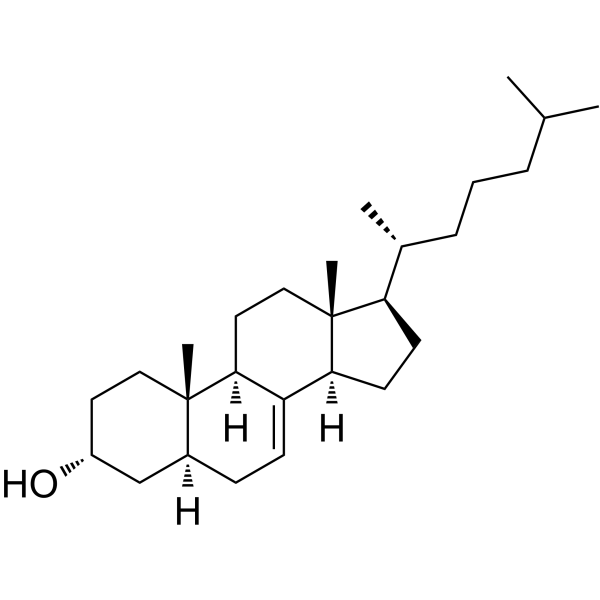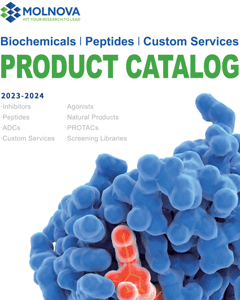
Lathosterol
CAS No. 80-99-9
Lathosterol( —— )
Catalog No. M26736 CAS No. 80-99-9
Lathosterol is a cholesterol-like endogenous metabolite. Serum Lathosterol concentration can be used as an indicator of whole-body cholesterol synthesis.
Purity : >98% (HPLC)
 COA
COA
 Datasheet
Datasheet
 HNMR
HNMR
 HPLC
HPLC
 MSDS
MSDS
 Handing Instructions
Handing Instructions
| Size | Price / USD | Stock | Quantity |
| 5MG | 106 | Get Quote |


|
| 10MG | 158 | Get Quote |


|
| 25MG | 267 | Get Quote |


|
| 50MG | 399 | Get Quote |


|
| 100MG | 575 | Get Quote |


|
| 500MG | 1197 | Get Quote |


|
| 1G | Get Quote | Get Quote |


|
Biological Information
-
Product NameLathosterol
-
NoteResearch use only, not for human use.
-
Brief DescriptionLathosterol is a cholesterol-like endogenous metabolite. Serum Lathosterol concentration can be used as an indicator of whole-body cholesterol synthesis.
-
DescriptionLathosterol is a cholesterol-like endogenous metabolite. Serum Lathosterol concentration can be used as an indicator of whole-body cholesterol synthesis.
-
In Vitro——
-
In Vivo——
-
Synonyms——
-
PathwayProteasome/Ubiquitin
-
TargetEndogenous Metabolite
-
RecptorCDK9
-
Research Area——
-
Indication——
Chemical Information
-
CAS Number80-99-9
-
Formula Weight386.664
-
Molecular FormulaC27H46O
-
Purity>98% (HPLC)
-
SolubilityIn Vitro:?Ethanol : 33.33 mg/mL (86.20 )
-
SMILES[H][C@@]12CC[C@H]([C@H](C)CCCC(C)C)[C@@]1(C)CC[C@@]1([H])C2=CC[C@@]2([H])C[C@H](O)CC[C@]12C
-
Chemical Name——
Shipping & Storage Information
-
Storage(-20℃)
-
ShippingWith Ice Pack
-
Stability≥ 2 years
Reference



-
7α,25-Dihydroxychole...
7α, 25-dihydroxycholesterol (7α,25-OHC) is a potent and selective agonist and endogenous ligand of the orphan GPCR receptor EBI2 (GPR183). 7α, 25-dihydroxycholesterol can serve as a chemokine directing migration of B cells, T cells and dendritic cells[1][2], and it is highly potent at activating EBI2 (EC50=140 pM; Kd=450 pM).
-
3-Methyl-2-oxovaleri...
3-Methyl-2-oxovaleric acid is an abnormal metabolite that arises from the incomplete breakdown of branched-chain amino acids. 3-Methyl-2-oxovaleric acid is a neurotoxin an acidogen and a metabotoxin. A neurotoxin causes damage to nerve cells and nerve tissues.
-
3,4-Dihydroxymandeli...
3,4-Dihydroxymandelic acid exists in all living organisms, ranging from bacteria to humans.



 Cart
Cart
 sales@molnova.com
sales@molnova.com


